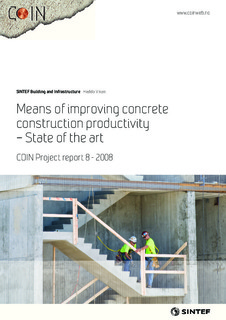| dc.description.abstract | The productivity in the construction sector has had negative development compared with other industries. The level of innovation within the industry is, moreover, considered by many to be too low. This literature review attempts to make an overview of the different stages of construction and to highlight areas with potential for improvement. The report focuses therefore on planning as well as production processes.
Planning has been rated as the most influencing factor for achieving construction productivity improvement. Site managers and designers must ensure good site layout and work flow, uncomplicated specifications and reasonable standardization in order to achieve higher construction site productivity. Buildability is another key-factor to productivity. The principles of achieving a buildable design are referred to as the 3S’s: Standardization, simplicity and simple integrated elements.
Formwork, reinforcing and placing of concrete has been identified as main factors dominating the consumption of time and money in relation to reinforced concrete jobs. The review has shown that
• Fibre reinforcement has the advantage of being significantly less labour-intensive than rebar reinforcement, and thus meets both the demand for improved efficiency and future shortage of skilled workers. Fibre reinforcement is a focus area within COIN.
• Self-compacting concrete, SCC, and pumping versus crane and skip combinations have been discussed in relation to placing methods. SCC has been described as one of the most innovative developments in the field of concrete technology. Reduced construction costs and improved work environment is two of many benefits of using SCC compared with traditional vibrated concrete.
• The use of concrete pumps can provide certain advantages over other methods of concrete placement: The quality of pumped concrete is maintained even in adverse weather conditions as it is permanently protected in the pipeline. Placing by pump is, moreover, usually the quickest method. Pumping as placing method can thus lead to reduced costs with regard to overall programme time savings and crew sizes. Additional cost related to the concrete must be kept in mind since pumped concrete generally requires additional cement in the mix. Volume must also be taken into account since placing speeds and costs improve with pour size. Pumpability is a focus area within COIN.
Formwork is not a focus area within COIN within 2008/2009
The precast sector is associated with several benefits concerning productivity and quality. The magnitude of cost reductions followed by choosing either precast or in-situ solutions is discussed. In Hong Kong prefabrication is not considered to decrease construction cost, but to increase quality and efficiency. Another efficiency study shows on the other hand that choosing either in-situ or precast systems consistently throughout the project was of more importance than the system itself.
Innovative construction systems are exemplified by BIG CANOPY. The system is mainly applied to buildings of at least twenty stories so as to remain cost-effective. BIG CANOPY consist of a parallel material delivery system with automated overhead cranes and one large construction lift under an all-weather synchronously climbing temporary roof frame. The following applications were added in order to further optimize productivity: A material management system, extensive prefabrication and unification of construction materials, and versatile workers. | |
